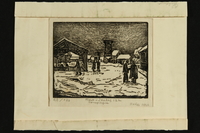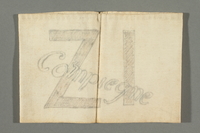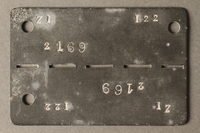Overview
- Brief Narrative
- Watercolor still life painting of fruit and a pitcher created by artist David Goychman while he was a prisoner in Compiègne internment camp in 1941. The painting was acquired by George Waldman, who was held in Compiègne from December 1941 to July 1943. George, Betsy, and their teenage son, John, were American citizens who lived in Paris to manage their paper import-export business. In response to the German invasion of Poland, France declared war on Germany on September 3, 1939. In May of 1940, Germany invaded and quickly defeated France, occupying the northern half of the country. In 1941, the Germans began rounding up foreign born Jewish residents. Goychman, a native of the Soviet Union, was arrested in Paris in June 1941 and detained in Compiègne internment camp. In the camp he continued to paint and took part in an art exhibition held in the camp. On December 12, 1941, a day after Germany declared war on the United States, George Waldman was arrested and detained at Compiègne as an enemy alien and later joined his wife and son in Vittel internment camp. In 1942, the Germans began to systematically deport foreign born Jews to concentration camps in the east. On September 11, 1942, Goychman was transferred to Drancy internment and transit camp. Three days later, he was deported to Auschwitz-Birkenau killing center in German-occupied Poland under the name Leizer Goychman. Goychman was killed at Auschwitz on September 19, 1942. This may be the only known surviving Goychman painting from his time in the camp.
- Date
-
creation:
1941 June 17-1941 December 31
- Geography
-
creation:
Compiegne (Concentration camp);
Compiegne (France)
- Credit Line
- United States Holocaust Memorial Museum Collection, Gift of Deborah Pearson and Janet Waldman
- Signature
- front, bottom right, handwritten, pencil : Goychman 1941. / Front Stalag 122.
- Contributor
-
Subject:
George L. Waldman
Artist: David Goychman
Subject: David Goychman
- Biography
-
George Louis Waldman (1890-1972, b. Jules Chazanoff) was born in Stepan, in the Russian Empire (now, Ukraine) to Boroch (1856-1941) and Bella Spelman Waldman (1860-1949). George had 3 younger brothers and a younger sister. In 1910 he immigrated to the United States via Montreal, Canada, on the Allen Train Line. George worked as a plumber before starting a paper import-export business. He married Betsy Stackowitz (1898-1970) on March 28, 1917 in Boston Massachusetts. Betsy was born in London, England, and immigrated to the United States in 1906. They had two sons, Milton Albert Waldman (1918-2002) and John Robert Waldman (1928-1973). As part of their paper business, the Waldmans established an office in Paris, and split their time living in France and the U.S. At the onset of World War II George, Betsy, and John were staying in France.
On September 1, 1939, Germany invaded Poland and two days later, France and Britain declared war on Germany. In May 1940, Germany invaded France and occupied the northern half of the country. After the conquest, the Germans did not bother American citizens living in France, including the Waldman family, despite their Jewish heritage. Jewish citizens from the United States and western enemy states were exempted from the German anti-Semitic policies because of their potential prisoner exchange value during the war. On December 11, 1941, four days after the Japanese attack on Pearl Harbor, Germany declared war on the United States. The next day, George was arrested and detained in Compiègne internment camp as an enemy alien. While in Compiègne George lived in military style barracks. On January 11, 1943, Betsy and John were arrested and detained at Vittel internment camp. In July, George was removed from Compiègne, taken to Vittel, and reunited with his family. In Vittel, the Waldman’s had hotel-like accommodations with running water and heat. They were able to send and receive mail, and received weekly Red Cross packages. The Germans published propaganda photos and press stories about Vittel to showcase it as representative of conditions in German camps.
On September 12, 1944, the Vittel internment camp was liberated by Free French forces. The Waldmans returned to Paris, and found their business had been sold to a Frenchman, and their home had been used by the Germans. George was able to secure the return of the business and their home. The family returned to Boston on the SS James Price in October 1945. Upon returning home, George, Betsy, and John learned that Milton had joined the army and fought in the Pacific Theater against the Empire of Japan. Even though they were in contact with him during their internment, Milton did not want to worry them so he kept his service a secret until their return. One of George’s younger brothers, Isaac, was deported from Drancy transit camp in France to Auschwitz-Birkenau killing center in German-occupied Poland on June 22, 1942. He died in Auschwitz on July 23, 1942.
David Goychman (1900-1942) was born in Bogopol, in the Russian Empire (now Ukraine). His father was Rabbi Wolf Goychman and he had three siblings; a sister and older brothers Abraham and Eliezer. Abraham died fighting in World War I and Eliezer was murdered in a pogrom. In 1919, Goychman moved to Palestine and began painting. In 1922, he moved to France, to study at the Academy of Art in Paris. During this time Goychman married his wife, Fania. In France, he made a living retouching photographic portraits, while painting portraits and landscapes. With the increase of anti-Semitism in the 1930s, Goychman’s sister, who had moved to the United States, invited him to join her, but he declined. On September 1, 1939, Germany invaded Poland and two days later, France and Britain declared war on Germany. In May 1940, Germany conquered France and occupied the northern half of the country. In 1941, German authorities began rounding up Jewish residents who were not born in France. On June 17, Goychman was arrested and detained in Compiègne internment camp. While in Compiègne he continued to paint and took part in an art exhibition in the camp. On September 11, 1942, Goychman was transferred to Drancy internment and transit camp. Three days later, he was deported to Auschwitz-Birkenau killing center in German-occupied Poland on transport no. 32 under the name Leizer Goychman. He was killed at Auschwitz on September 19, 1942.
Physical Details
- Classification
-
Art
- Category
-
Paintings
- Object Type
-
Watercolor painting (lcsh)
- Genre/Form
- Art.
- Physical Description
- Watercolor painting of apples and a pitcher against an indistinct pastel colored background. In the foreground are six apples: the far left, is small, green colored with brown shading and a long stem, the second from left is yellow with green shading on the top and left, the third is green with a short stem, the fourth is greenish-yellow with brown shading on the left side and a short stem, the back right is red with yellow shading and the lower right is small and red. Behind the apples is a white pitcher with the pouring spout on the left and a handle on the right side. Each corner of the paper has a small pushpin hole, and the back of the paper is slightly yellowed with small brown stains throughout.
- Dimensions
- overall: Height: 7.125 inches (18.098 cm) | Width: 10.125 inches (25.718 cm)
- Materials
- overall : paper, paint, pencil
Rights & Restrictions
- Conditions on Access
- No restrictions on access
- Conditions on Use
- Restrictions on use. The United States Holocaust Memorial Museum does not own copyright to this material. No information about the copyright was included on the Deed of Gift.
Keywords & Subjects
- Topical Term
- Compiègne (Concentration camp)--Pictorial works. Concentration camp inmates as artists--France--Compiègne--Biography. Concentration camps in art--France--Compiegne--Pictorial works. Holocaust, Jewish (1939-1945), in art--France. Jewish artists--France. World War, 1939-1945--Prisoners and prisons. Deportees--France.
- Geographic Name
- Paris (France) Poland.
- Personal Name
- Goychman, David, 1900-1942.
Administrative Notes
- Legal Status
- Permanent Collection
- Provenance
- The painting was donated to the United States Holocaust Memorial Museum in 2018 by Deborah Pearson, the daughter of John Waldman and the granddaughter of George and Betsy Waldman.
- Record last modified:
- 2023-12-15 15:03:46
- This page:
- https://collections.ushmm.org/search/catalog/irn619221
Download & Licensing
In-Person Research
- By Appointment
- Request 21 Days in Advance of Visit
- Plan a Research Visit
- Request to See This Object
Contact Us
Also in Waldman family collection
The collection consists of artifacts, artwork, documents, correspondence, photographs, and newspaper clippings, relating to the experiences of John, George, and Betsy Waldman in Compiègne and Vittel internment camps and artists Jacques Gotko and David Goychman in Compiègne internment camp in France, during the Holocaust.
Date: approximately 1940-approximately 1945

Black and white linocut print of the Compiègne internment camp created by Jacques Gotko
Object
Linocut print of a yard in the Compiègne internment camp in German-occupied France created by artist Jacques Gotko in 1942. The print was acquired by George Waldman, who was held in Compiègne from December 1941 to July 1943. George, Betsy, and their teenage son, John, were American citizens who lived in Paris to manage their paper import-export business. In response to the German invasion of Poland, France declared war on Germany on September 3, 1939. In May of 1940, Germany invaded and quickly defeated France, occupying the northern half of the country. In 1941, the Germans began rounding up foreign born Jewish residents. Gotko, a native of the Soviet Union, was arrested in Paris in July 1941 and detained in Compiègne internment camp. In the camp Gotko painted watercolors, drew pencil sketches, and created linocuts of life in the camp and sent his earnings from portrait commissions to his wife. On December 12, 1941, a day after Germany declared war on the United States, George Waldman was arrested and detained at Compiègne as an enemy alien and later joined his wife and son in Vittel internment camp. In 1942, the Germans began to deport foreign born Jews to concentration camps in the east. In September, Gotko was transferred to Drancy internment and transit camp where he was reunited with his mother and sister. In November, his mother and sister were deported to Auschwitz-Birkenau concentration camp in German-occupied Poland. On July 18, 1943, Gotko was deported to Auschwitz, given prisoner number 130612, and was selected for forced labor. Gotko died of typhus on January 2, 1944, in Auschwitz.

Armband worn by a Jewish American prisoner in Compiègne internment camp
Object
Armband worn by George Waldman while he was held in Compiègne internment camp in France, from December 1941 to July 1943. George, Betsy, and their teenage son John were American citizens who lived in Paris to manage their paper import-export business. On September 3, 1939, in response to the German invasion of Poland, France declared war on Germany. In May of 1940, Germany invaded and quickly defeated France, occupying the northern half of the country. Despite their Jewish heritage, the Waldmans were left alone by the Germans due to their American citizenship. In response to the attack on Pearl Harbor, the United States declared war on Japan. Subsequently, Germany declared war on the U.S. on December 11, 1941. The next day George was arrested and detained at Compiègne as an enemy alien. On January 11, 1943, Betsy and John were arrested and detained in Vittel internment camp. In July, George was removed from Compiègne, taken to Vittel, and reunited with his family. Due to their American citizenship, the Waldmans received better treatment than other prisoners at the internment camps. They had hotel like accommodations, with heat and running water, were able to send and receive mail, and received weekly Red Cross packages. On September 12, 1944, the Vittel internment camp was liberated by Free French forces and the Waldmans returned to the United States in October 1945.

Prisoner ID tag issued to a Jewish American prisoner in Compiègne internment camp
Object
Prisoner ID tag issued to George Waldman, while he was held in Compiègne internment camp in France, from December 1941 to July 1943. George, Betsy, and their teenage son, John, were American citizens who lived in Paris to manage their paper import-export business. On September 3, 1939, in response to the German invasion of Poland, France declared war on Germany. In May of 1940, Germany invaded and quickly defeated France, occupying the northern half of the country. Despite their Jewish heritage, the Waldmans were left alone by the Germans due to their American citizenship. In response to the attack on Pearl Harbor, the United States declared war on Japan. Subsequently, Germany declared war on the U.S. on December 11, 1941.The next day George was arrested and detained at Compiègne as an enemy alien. On January 11, 1943, Betsy and John were arrested and detained in Vittel internment camp. In July, George was removed from Compiègne, taken to Vittel, and reunited with his family. Due to their American citizenship, the Waldmans received better treatment than other prisoners at the internment camps. They had hotel like accommodations, with heat and running water, were able to send and receive mail, and received weekly Red Cross packages. On September 12, 1944, the Vittel internment camp was liberated by Free French forces and the Waldmans returned to the United States in October 1945.
Waldman family papers
Document
Documents, correspondence, photographs and newspaper clippings that belonged to John Waldman (donor's father) and his parents George and Betsy Waldman, who were interned as American citizens in Vittel internment camp in France.



